Protective Characteristics of TiO2 Sol-Gel Layer Deposited on Zn-Ni or Zn-Co Substrates
Abstract
1. Introduction
2. Materials and Methods
2.1. Sample Types
- -
- System A: Zn-Ni (10 wt.%)—under-layer; TiO2—top-layer;
- -
- System B: Zn-Co (3 wt.%)—under-layer; TiO2—top-layer.
2.2. SEM/EDX Investigations
2.3. AFM Studies
2.4. Contact Angle Measurements
2.5. Chemical and Phase Composition
2.6. XRD Analyses
2.7. Electrochemical Tests
2.8. Corrosive Medium and Reproducibility
3. Results
3.1. SEM Investigations
- (i)
- presence of Ti peak in EDX after the corrosion test;
- (ii)
- the surface morphology of TiO2 coating remains almost unchanged, and any signs of corrosion such as cracks, craters, pits and etc. are not observable.
3.2. Surface Topography by AFM Studies
3.3. Phase Composition
3.4. XPS Investigations
3.5. Electrochemical Investigations
4. Discussion
5. Conclusions
- -
- suitable surface morphology, i.e., the surface is more even and uniform, without holes, pits or cracks;
- -
- the system is characterized by a greater degree of amorphousness of the top-layer, which is confirmed by XRD studies;
- -
- the appearance of a newly formed intermetallic compound, CoZn13, which demonstrates better corrosion resistance.
Author Contributions
Funding
Institutional Review Board Statement
Informed Consent Statement
Data Availability Statement
Acknowledgments
Conflicts of Interest
References
- Koch, G.; Brongers, M.; Thomson, N.; Virmani, Y.; Payer, J. Corrosion Cost and Preventive Strategies in the United States; NACE International: Washington, DC, USA, 2016. [Google Scholar]
- Zhang, X.G. Corrosion and Electrochemistry of Zinc; Plenum Press: New York, NY, USA, 1996; ISBN 978-1-4757-9877-7. [Google Scholar]
- Kartsonakis, I.A.; Balaskas, A.C.; Koumoulos, E.P.; Charitidis, C.A.; Kordas, G.C. Incorporation of ceramic nanocontainers into epoxy coatings for the corrosion protection of hot dip galvanized steel. Corros. Sci. 2012, 57, 30–41. [Google Scholar] [CrossRef]
- El-Sayed, M.S.; Almajid, A.A.; Bairamov, A.K.; Al-Zahrani, E. A comparative study on the corrosion of Monel-400 in aerated and deaerated arabian gulf water and 3.5% sodium chloride solutions. Int. J. Electrochem. Sci. 2012, 7, 2796–2810. [Google Scholar]
- Boshkov, N.; Petrov, K.; Vitkova, S.; Nemska, S.; Raichevski, G. Composition of the corrosion products of galvanic coatings Zn-Co and their influence on the protective ability. Surf. Coat. Technol. 2002, 157, 2–3. [Google Scholar] [CrossRef]
- Boshkov, N.; Petrov, K.; Kovacheva, D.; Vitkova, S.; Nemska, S. Influence of the alloying component on the protective ability of some zinc galvanic coatings. Electrochim. Acta 2005, 51, 77–84. [Google Scholar] [CrossRef]
- Bachvarov, V.; Peshova, M.; Vitkova, S.; Boshkov, N. Corrosion properties of Zn-Ni-P alloys in neutral model medium. Cent. Eur. J. Chem. 2014, 12, 1183–1193. [Google Scholar] [CrossRef]
- Gaber, G.A.; Mohamed, L.Z.; Järvenpää, A.; Hamada, A. Enhancement of corrosion protection of AISI 201 austenitic stainless steel in acidic chloride solutions by Ce-doped TiO2 coating. Surf. Coat. Technol. 2021, 423, 127618. [Google Scholar] [CrossRef]
- Rahmani-Azad, M.; Najafi, A.; Rahmani-Azad, N.; Khalaj, G. Improvement of ZrB2 nanopowder synthesis by sol-gel method via zirconium alkoxide/boric acid precursors, J. Sol-Gel Sci Technol. 2022, 103, 87–96. [Google Scholar] [CrossRef]
- Najafi, A.; Sharifi, F.; Mesgari-Abbasi, S.; Khalaj, G. Influence of pH and temperature parameters on the sol-gel synthesis process of meso porous ZrC nanopowder. Ceram Intern. 2022, 48, 26725–26731. [Google Scholar] [CrossRef]
- Curkovic, L.; Curkovic, H.; Salopek, S.; Renjo, M.; Šegota, S. Enhancement of corrosion protection of AISI 304 stainless steel by nanostructured sol–gel TiO2 films. Corros. Sci. 2013, 77, 176–184. [Google Scholar] [CrossRef]
- Park, J.H.; Kim, W.S.; Du-Hwan, J.; Kim, J.S.; Park, J.M. Effect of Ce conversion underlayer coating on the photo-catalytic activity of TiO2 sol–gel film deposited on hot-dip GI. J. Ind. Eng. Chem. 2014, 20, 1965–1972. [Google Scholar] [CrossRef]
- Romero, R.; Martin, F.; Ramos-Barrado, J.R.; Leinen, D. Study of different inorganic oxide thin films as barrier coatings against the corrosion of galvanized steel. Surf. Coat. Technol. 2010, 204, 2060–2063. [Google Scholar] [CrossRef]
- López Ibáñez, R.; Martín, F.; Ramos-Barrado, J.R.; Leinen, D. Large area zirconia coatings on galvanized steel sheet. Surf. Coat. Technol. 2008, 202, 2408–2412. [Google Scholar] [CrossRef]
- Lopez Ibanez, R.; Romero, R.; Martın, F.; Ramos-Barrado, J.R.; Leinen, D. ZnO thin films on aluminized steel by spray pyrolysis. Surf. Interface Anal. 2006, 38, 789–792. [Google Scholar] [CrossRef]
- Stambolova, I.; Stoyanova, D.; Shipochka, M.; Boshkova, N.; Eliyas, A.; Simeonova, S.; Grozev, N.; Boshkov, N. Surface morphological and chemical features of anticorrosion ZrO2 –TiO2 coatings: Impact of zirconium precursor. Coatings 2021, 11, 703. [Google Scholar] [CrossRef]
- Stambolova, I.; Boshkov, N.; Boshkova, N.; Stoyanova, D.; Shipochka, M.; Simeonova, S.; Grozev, N. Environmentally-friendly Anticorrosive Layered Zirconia/Titania/Low-Carbon Steel Structures. Mater. Proc. 2021, 4, 75. [Google Scholar]
- Stambolova, I.; Boshkova, N.; Stoyanova, D.; Blaskov, V.; Simeonova, S.; Boshkov, N. Corrosion behavior of low-carbon steel coated with different type of TiO2/ZrO2 layers. J. Int. Sci. Publ. Mater. Methods Technol. 2020, 14, 300–307. [Google Scholar]
- Adamson, A.W.; Gast, A.P. Physical Chemistry of Surfaces, 6th ed.; John Wiley & Sons: New York, NY, USA, 1997; pp. 347–380. [Google Scholar]
- Chakarova, V.; Boiadjieva-Scherzer, T.; Kovacheva, D.; Kronberger, H.; Monev, M. Corrosion behavior of the ζ-CrZn13 phase obtained by annealing an electrodeposited Zn-Cr coating. Electrochem. Commun. 2021, 122, 106904. [Google Scholar] [CrossRef]
- Holgado, J.P.; Pérez-Sánchez, M.; Yubero, F.; Espinós, J.P.; González-Elipe, A.R. Corrosion resistant ZrO2 thin films prepared at room temperature by ion beam chemical vapor deposition. Surf. Coat. Technol. 2002, 151–152, 449–453. [Google Scholar] [CrossRef]
- Ghasemi, A.; Shahrabi, T.; Oskuie, A.A.; Hasannejad, H.; Sanjabi, S. Effect of heat treatment on corrosion properties of sol gel titania-ceria nanocomposite coatings. J. Alloys Comp. 2010, 504, 237–242. [Google Scholar] [CrossRef]
- Panagopoulos, C.N.; Lagaris, D.A.; Vatista, P.C. Adhesion and corrosion behavior of Zn-Co electrodeposits on mild steel. Mater. Chem. Phys. 2011, 126, 398–403. [Google Scholar] [CrossRef]
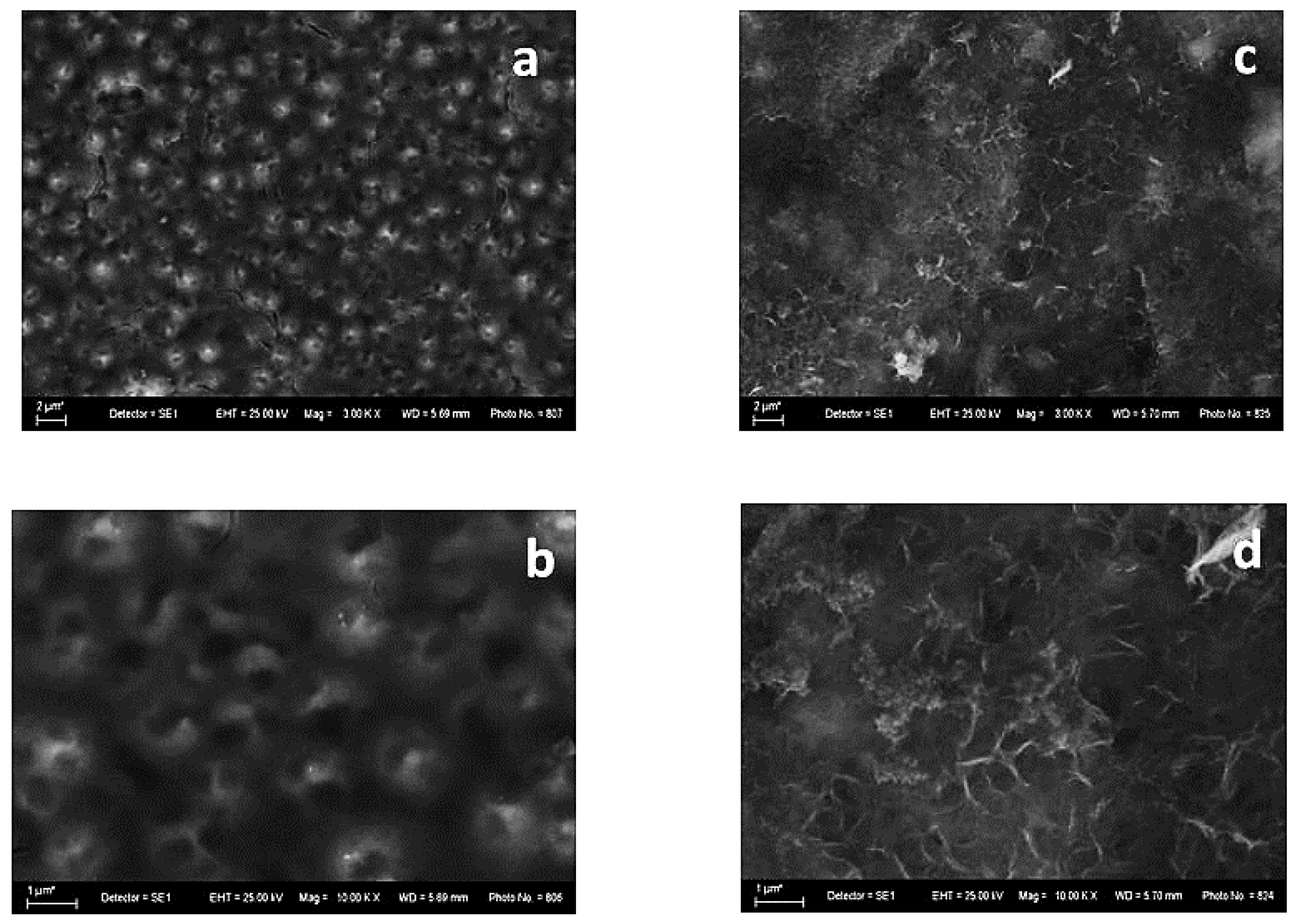

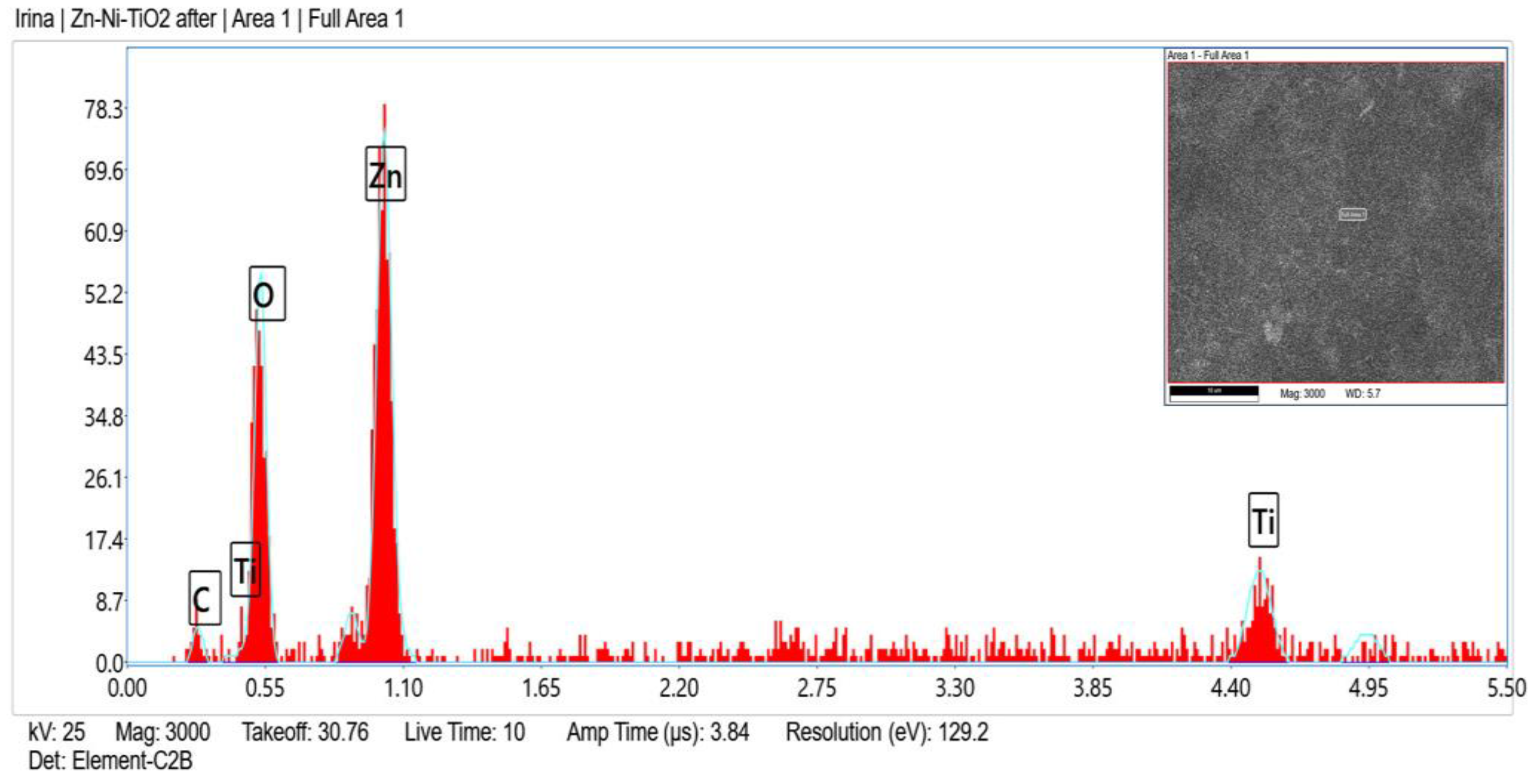
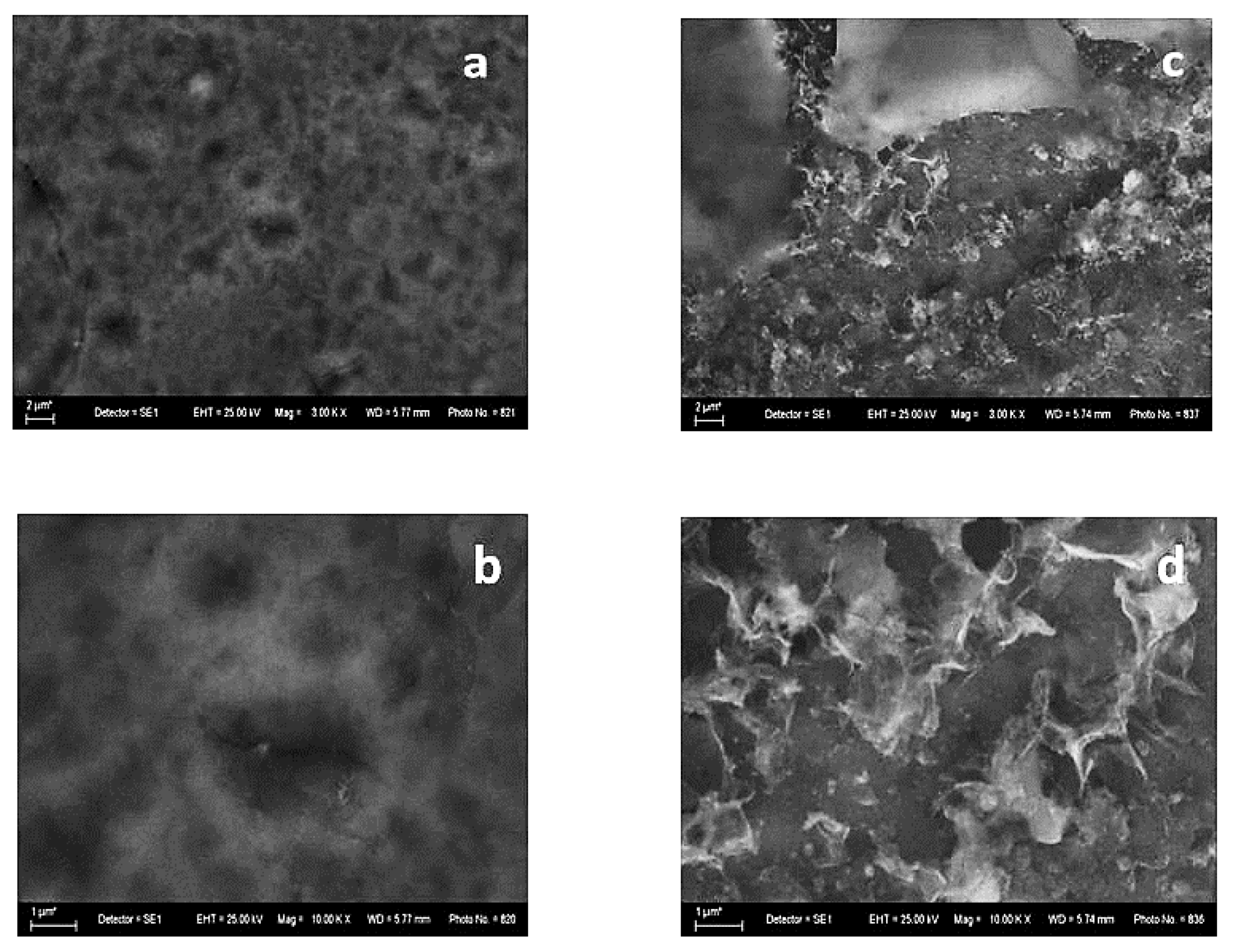
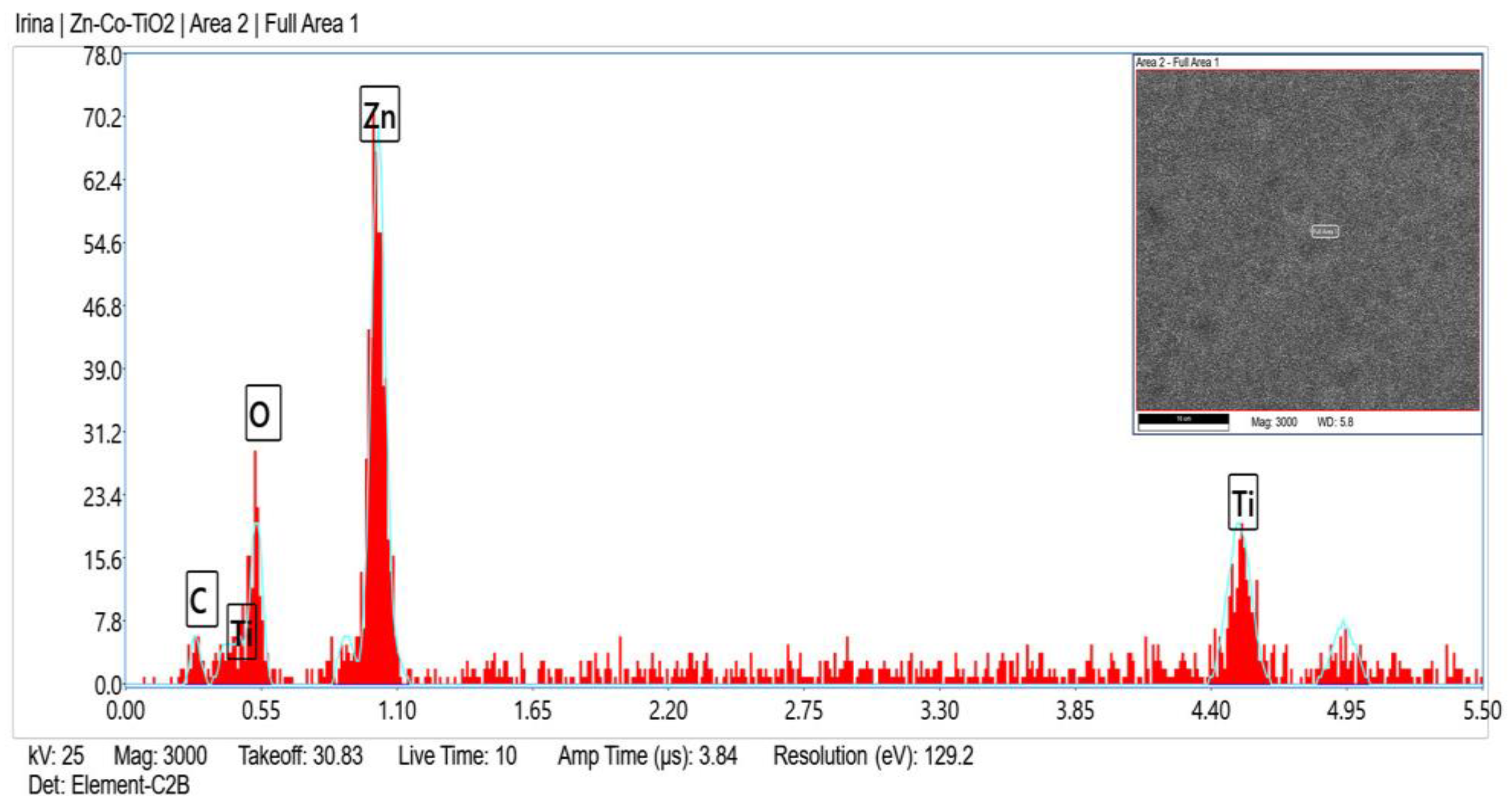
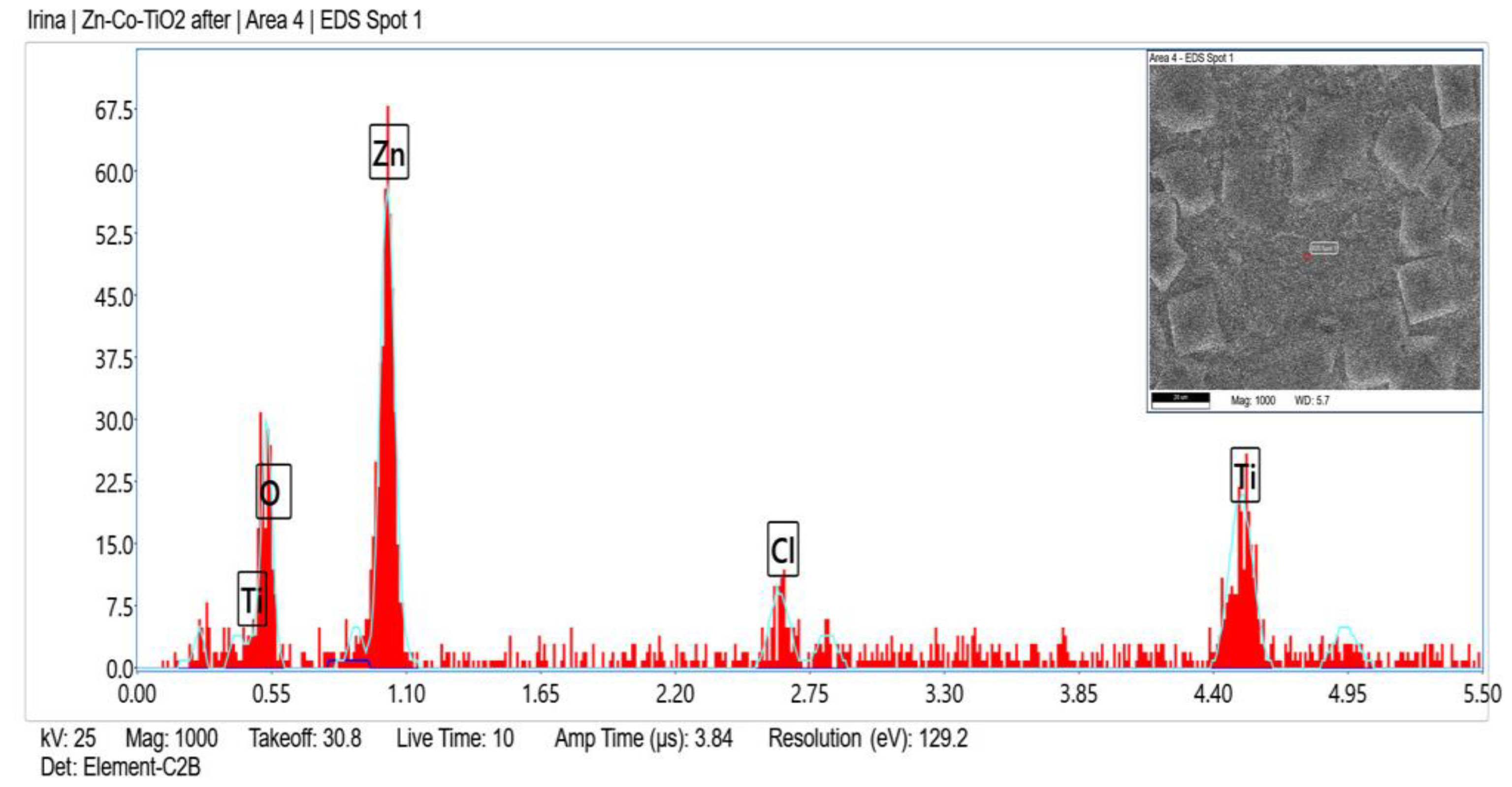
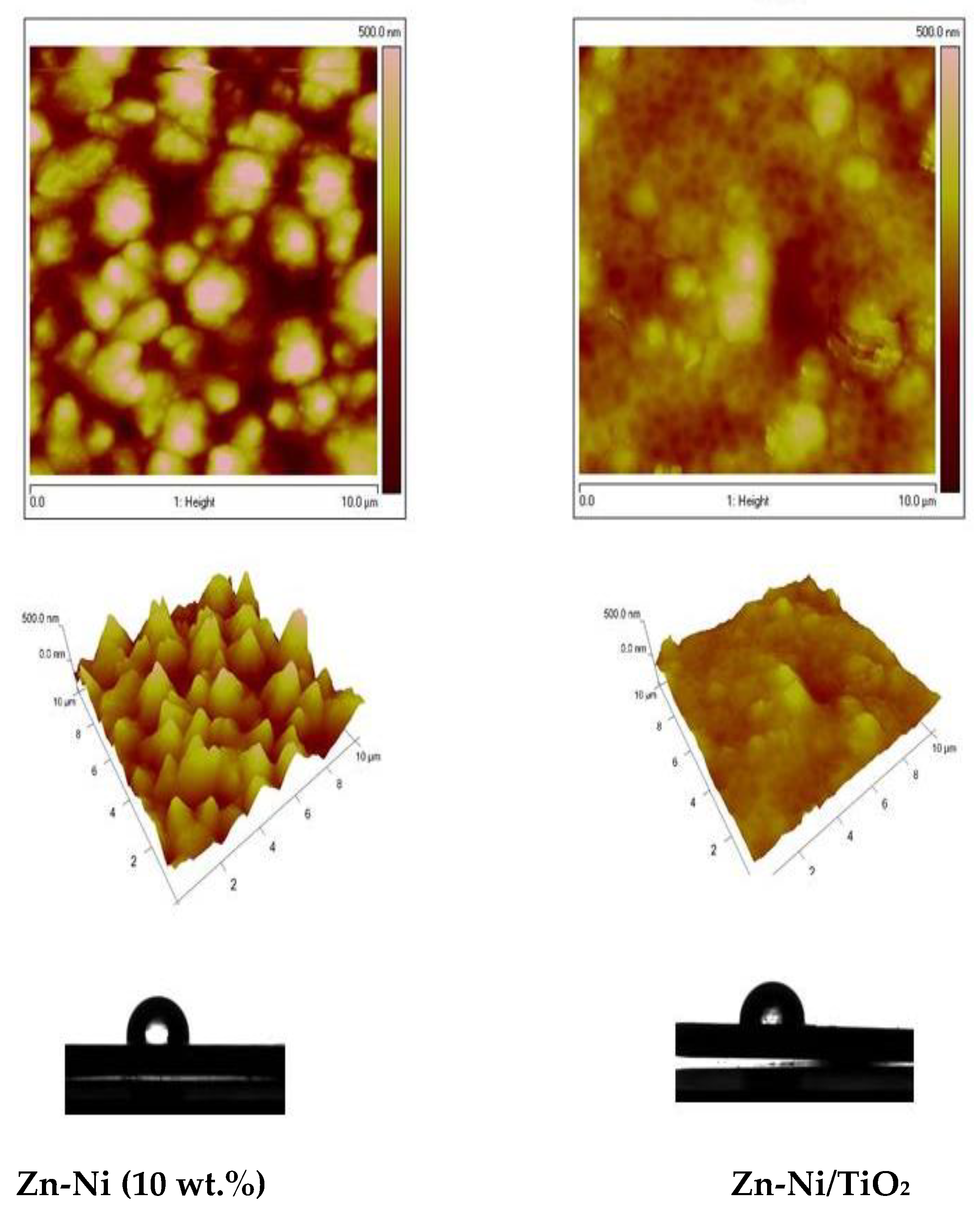

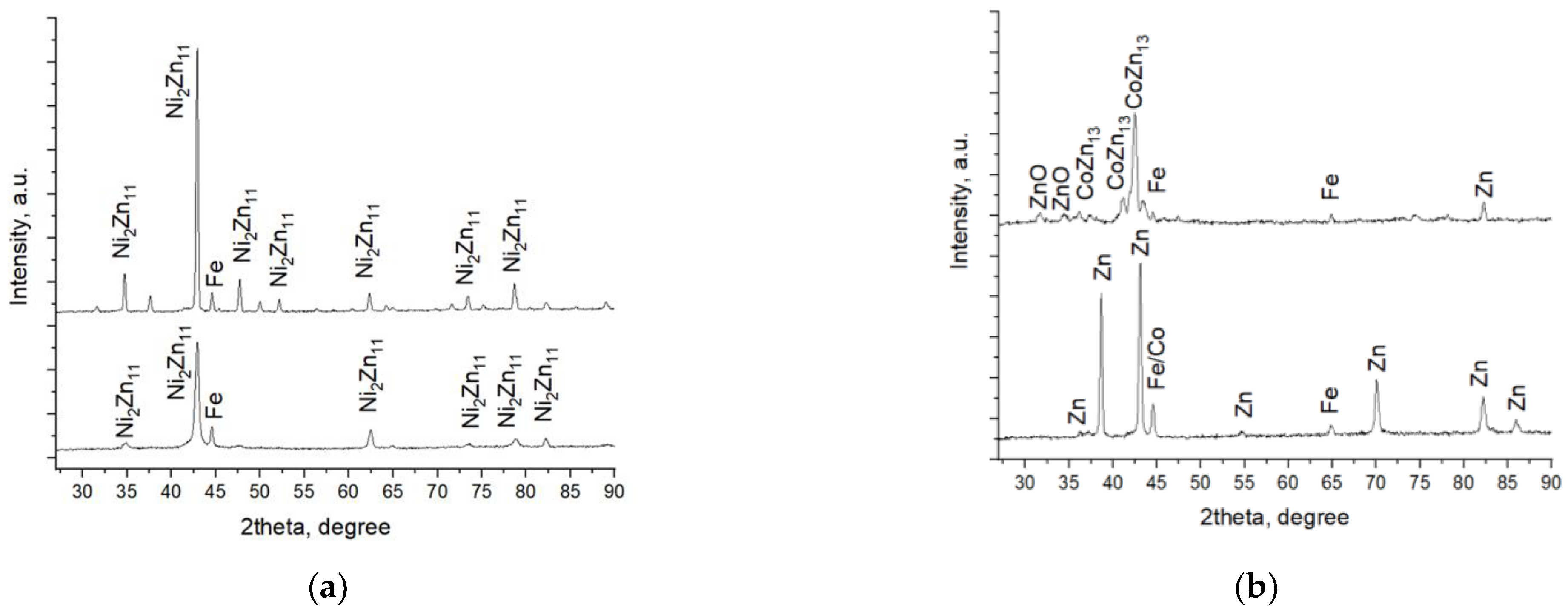

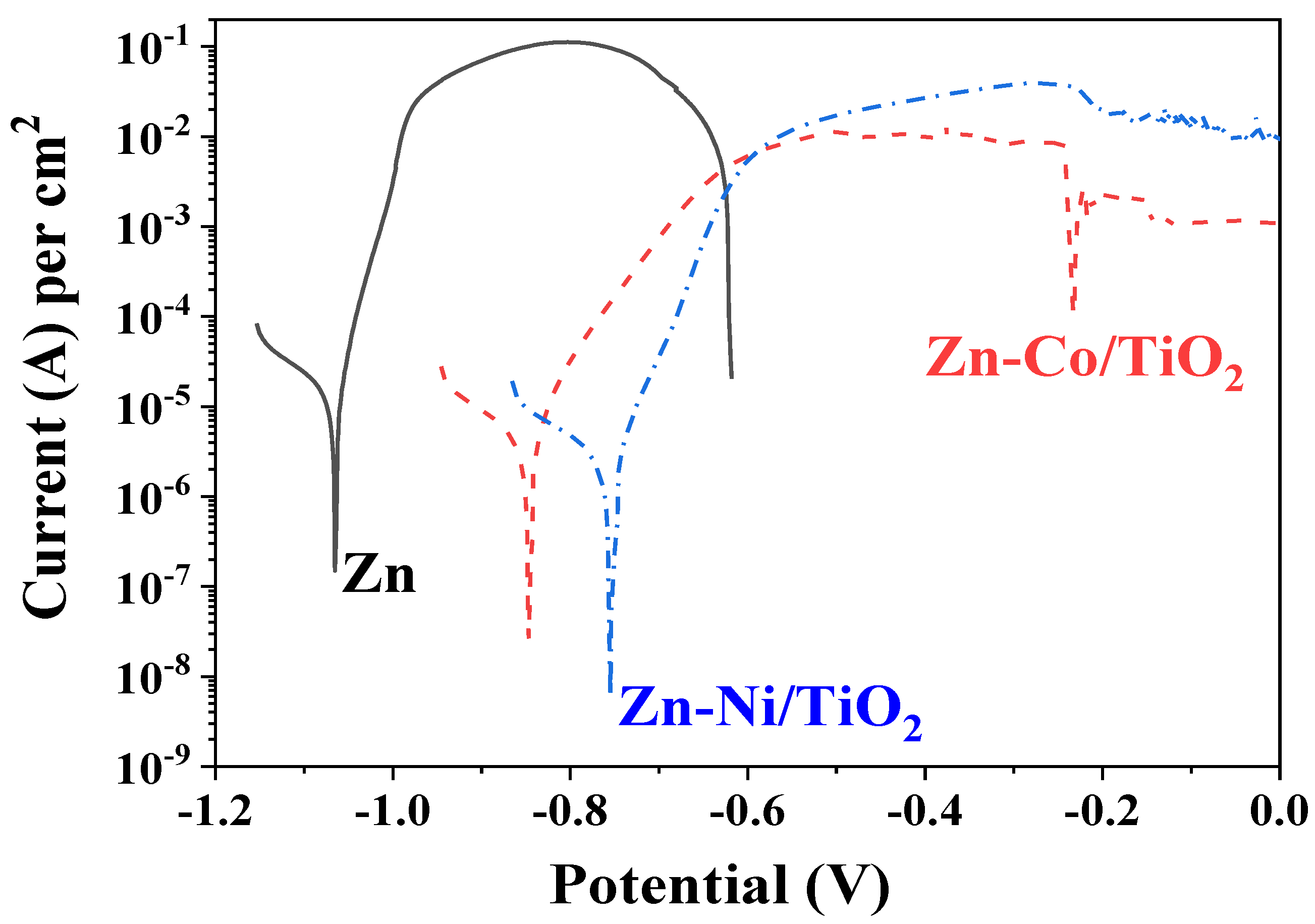
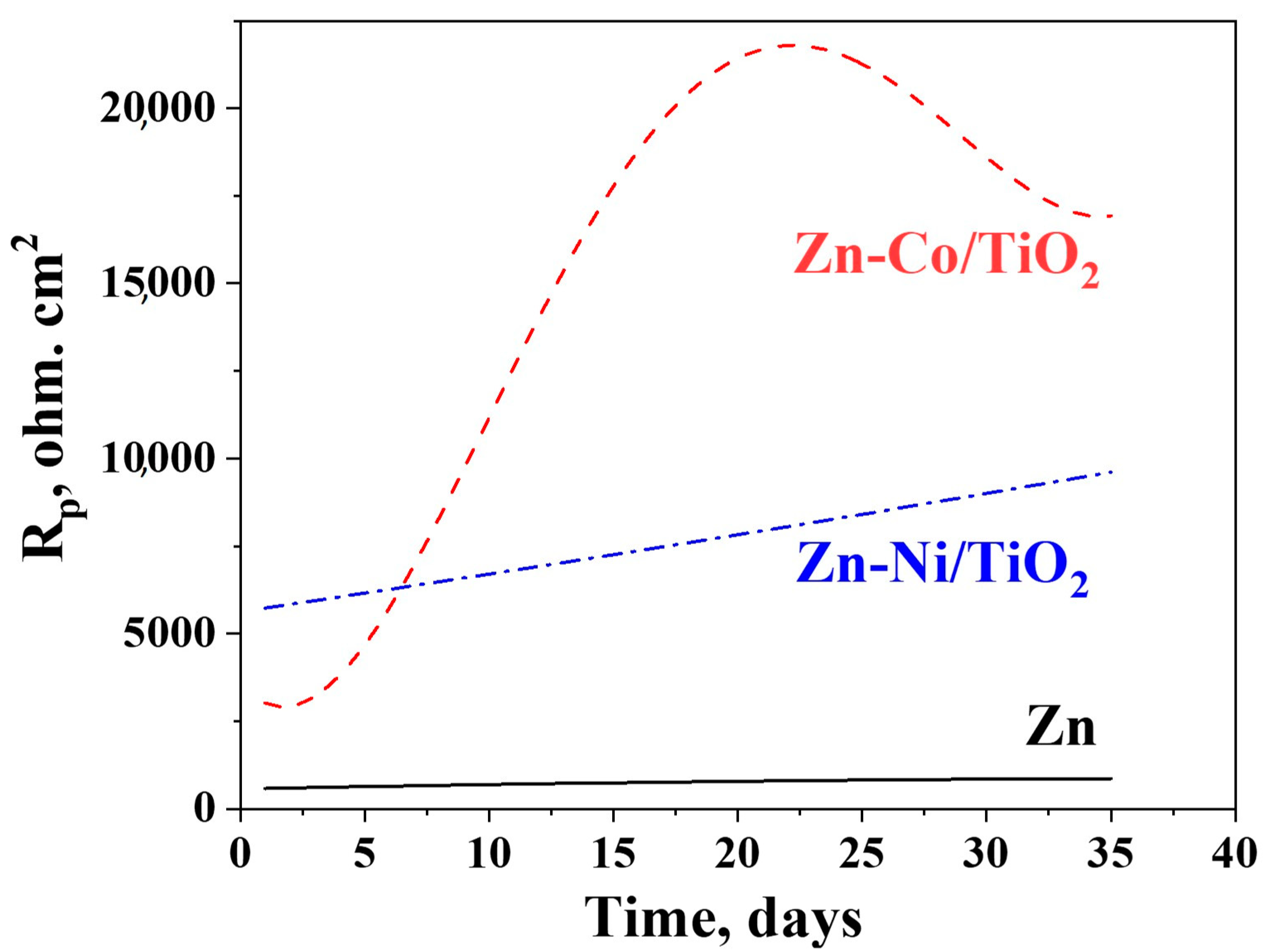
| Samples | Ra, nm | Rq, nm | Contact Angle |
|---|---|---|---|
| Zn-Ni System A | 99.5 | 125 | 97.3 |
| 36.7 | 49.5 | 93.2 | |
| Zn-Co System B | 77.8 | 94.6 | 106.5 |
| 41.1 | 53.4 | 95.5 |
| No. | Sample | Icorr, A.cm−2 | Ecorr, V |
|---|---|---|---|
| 1 | Ordinary Zn | 1.8 × 10−5 | −1.06 |
| 2 | Zn-Ni/TiO2 | 2.4 × 10−6 | −0.85 |
| 3 | Zn-Co/TiO2 | 3.5 × 10−6 | −0.75 |
| No. | Sample | Rp, Ohm.cm2 (35 Days) |
|---|---|---|
| 1 | Ordinary zinc | 885 |
| 2 | Zn-Ni/TiO2 | 9684 |
| 3 | Zn-Co/TiO2 | 16,918 |
Disclaimer/Publisher’s Note: The statements, opinions and data contained in all publications are solely those of the individual author(s) and contributor(s) and not of MDPI and/or the editor(s). MDPI and/or the editor(s) disclaim responsibility for any injury to people or property resulting from any ideas, methods, instructions or products referred to in the content. |
© 2023 by the authors. Licensee MDPI, Basel, Switzerland. This article is an open access article distributed under the terms and conditions of the Creative Commons Attribution (CC BY) license (https://creativecommons.org/licenses/by/4.0/).
Share and Cite
Boshkova, N.; Stambolova, I.; Stoyanova, D.; Simeonova, S.; Grozev, N.; Avdeev, G.; Shipochka, M.; Dimitrov, O.; Bachvarov, V.; Peshova, M.; et al. Protective Characteristics of TiO2 Sol-Gel Layer Deposited on Zn-Ni or Zn-Co Substrates. Coatings 2023, 13, 295. https://doi.org/10.3390/coatings13020295
Boshkova N, Stambolova I, Stoyanova D, Simeonova S, Grozev N, Avdeev G, Shipochka M, Dimitrov O, Bachvarov V, Peshova M, et al. Protective Characteristics of TiO2 Sol-Gel Layer Deposited on Zn-Ni or Zn-Co Substrates. Coatings. 2023; 13(2):295. https://doi.org/10.3390/coatings13020295
Chicago/Turabian StyleBoshkova, Nelly, Irina Stambolova, Daniela Stoyanova, Silviya Simeonova, Nikolay Grozev, Georgi Avdeev, Maria Shipochka, Ognian Dimitrov, Vasil Bachvarov, Miglena Peshova, and et al. 2023. "Protective Characteristics of TiO2 Sol-Gel Layer Deposited on Zn-Ni or Zn-Co Substrates" Coatings 13, no. 2: 295. https://doi.org/10.3390/coatings13020295
APA StyleBoshkova, N., Stambolova, I., Stoyanova, D., Simeonova, S., Grozev, N., Avdeev, G., Shipochka, M., Dimitrov, O., Bachvarov, V., Peshova, M., & Boshkov, N. (2023). Protective Characteristics of TiO2 Sol-Gel Layer Deposited on Zn-Ni or Zn-Co Substrates. Coatings, 13(2), 295. https://doi.org/10.3390/coatings13020295







